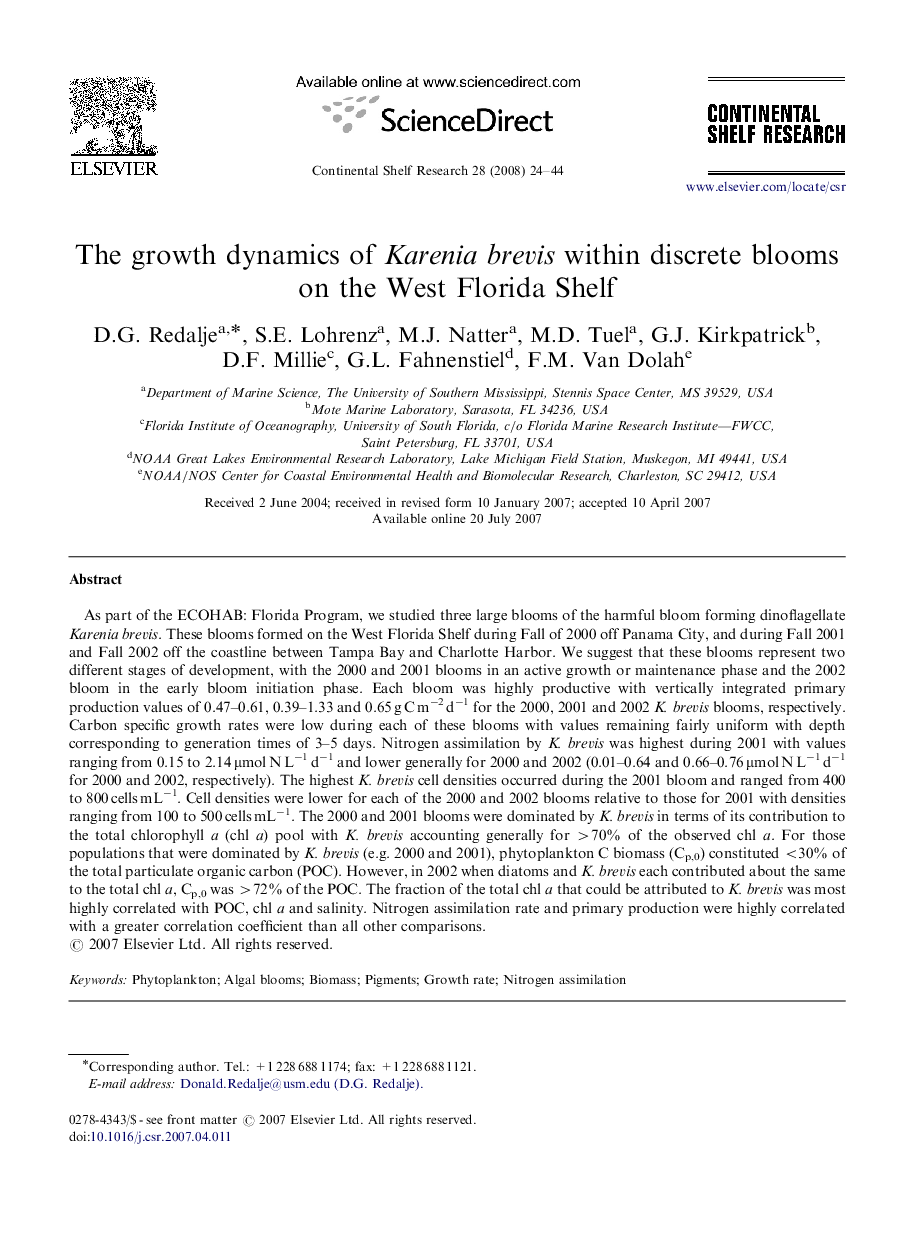| کد مقاله | کد نشریه | سال انتشار | مقاله انگلیسی | نسخه تمام متن |
|---|---|---|---|---|
| 4533349 | 1325185 | 2008 | 21 صفحه PDF | دانلود رایگان |
عنوان انگلیسی مقاله ISI
The growth dynamics of Karenia brevis within discrete blooms on the West Florida Shelf
دانلود مقاله + سفارش ترجمه
دانلود مقاله ISI انگلیسی
رایگان برای ایرانیان
کلمات کلیدی
موضوعات مرتبط
مهندسی و علوم پایه
علوم زمین و سیارات
زمین شناسی
پیش نمایش صفحه اول مقاله

چکیده انگلیسی
As part of the ECOHAB: Florida Program, we studied three large blooms of the harmful bloom forming dinoflagellate Karenia brevis. These blooms formed on the West Florida Shelf during Fall of 2000 off Panama City, and during Fall 2001 and Fall 2002 off the coastline between Tampa Bay and Charlotte Harbor. We suggest that these blooms represent two different stages of development, with the 2000 and 2001 blooms in an active growth or maintenance phase and the 2002 bloom in the early bloom initiation phase. Each bloom was highly productive with vertically integrated primary production values of 0.47-0.61, 0.39-1.33 and 0.65 g C mâ2 dâ1 for the 2000, 2001 and 2002 K. brevis blooms, respectively. Carbon specific growth rates were low during each of these blooms with values remaining fairly uniform with depth corresponding to generation times of 3-5 days. Nitrogen assimilation by K. brevis was highest during 2001 with values ranging from 0.15 to 2.14 μmol N Lâ1 dâ1 and lower generally for 2000 and 2002 (0.01-0.64 and 0.66-0.76 μmol N Lâ1 dâ1 for 2000 and 2002, respectively). The highest K. brevis cell densities occurred during the 2001 bloom and ranged from 400 to 800 cells mLâ1. Cell densities were lower for each of the 2000 and 2002 blooms relative to those for 2001 with densities ranging from 100 to 500 cells mLâ1. The 2000 and 2001 blooms were dominated by K. brevis in terms of its contribution to the total chlorophyll a (chl a) pool with K. brevis accounting generally for >70% of the observed chl a. For those populations that were dominated by K. brevis (e.g. 2000 and 2001), phytoplankton C biomass (Cp,0) constituted <30% of the total particulate organic carbon (POC). However, in 2002 when diatoms and K. brevis each contributed about the same to the total chl a, Cp,0 was >72% of the POC. The fraction of the total chl a that could be attributed to K. brevis was most highly correlated with POC, chl a and salinity. Nitrogen assimilation rate and primary production were highly correlated with a greater correlation coefficient than all other comparisons.
ناشر
Database: Elsevier - ScienceDirect (ساینس دایرکت)
Journal: Continental Shelf Research - Volume 28, Issue 1, January 2008, Pages 24-44
Journal: Continental Shelf Research - Volume 28, Issue 1, January 2008, Pages 24-44
نویسندگان
D.G. Redalje, S.E. Lohrenz, M.J. Natter, M.D. Tuel, G.J. Kirkpatrick, D.F. Millie, G.L. Fahnenstiel, F.M. Van Dolah,